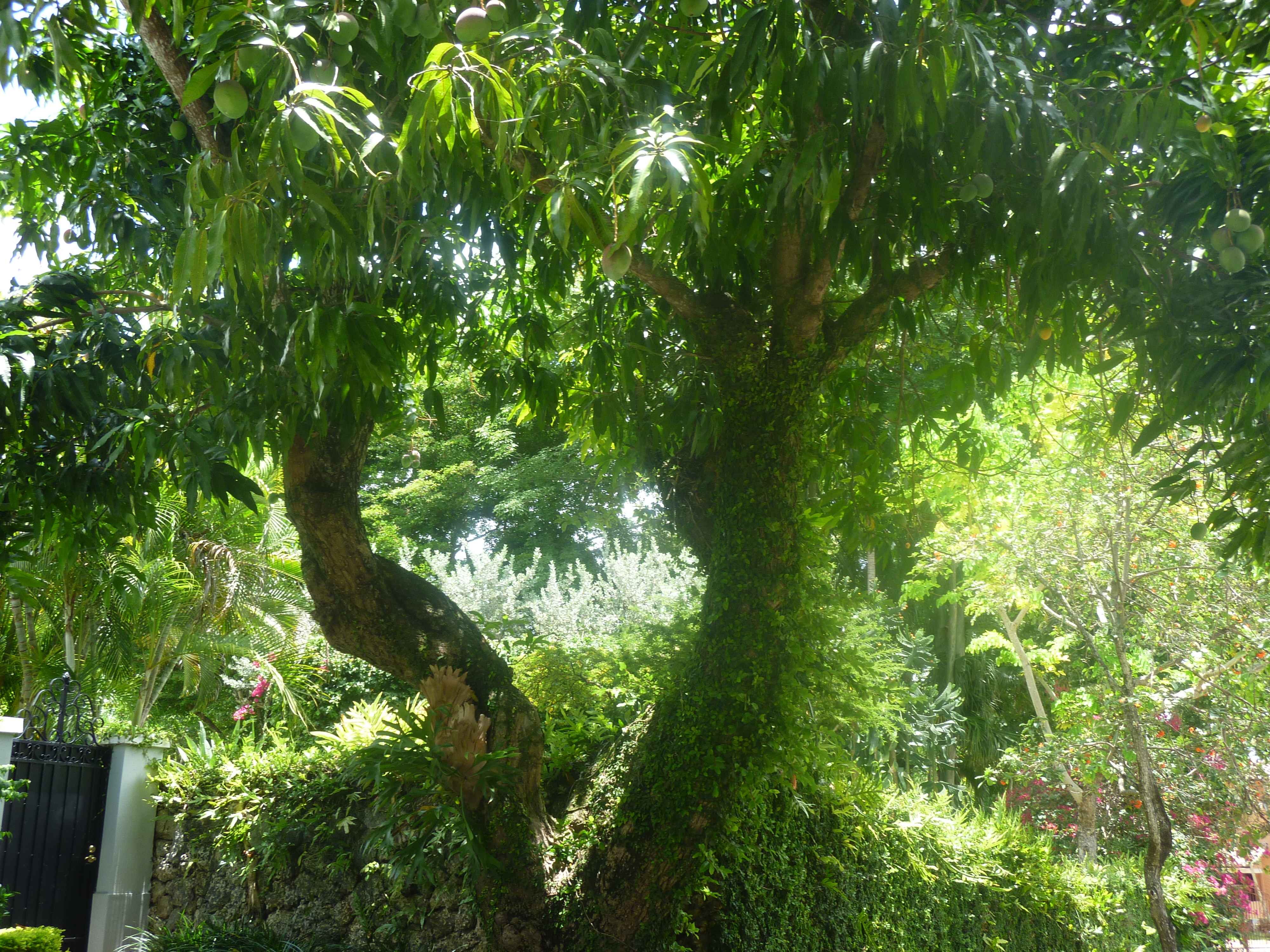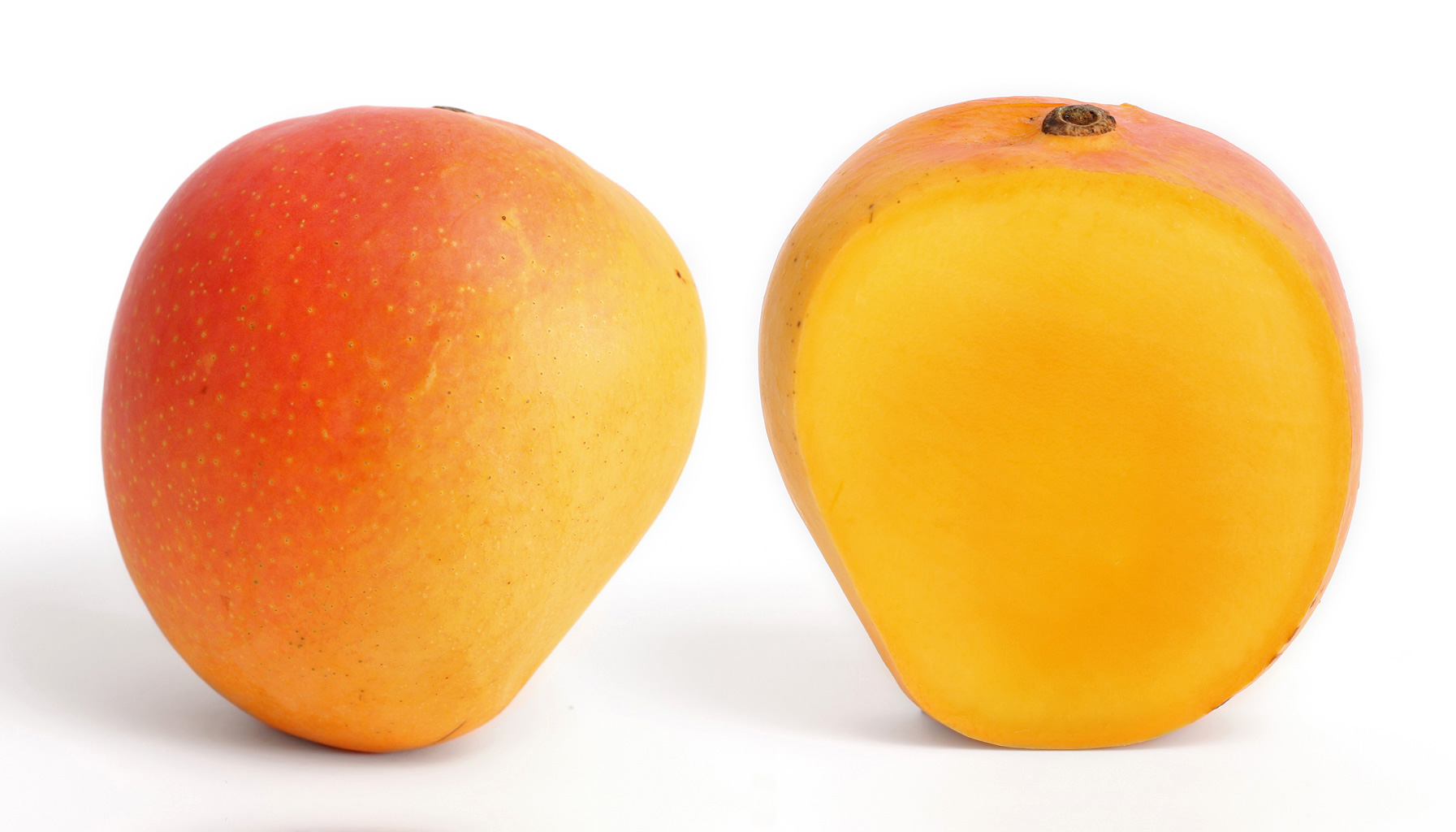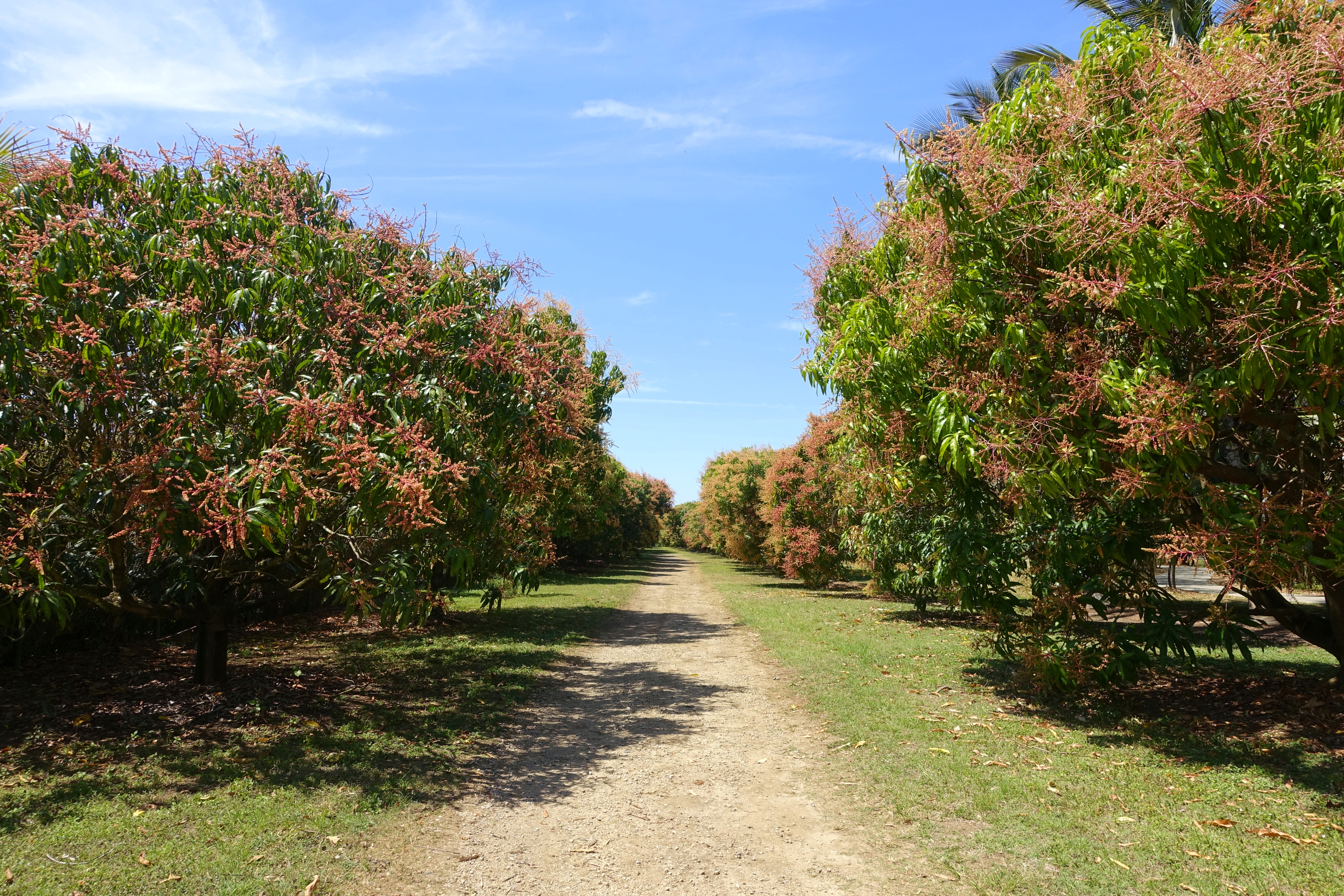|
Hatcher (mango)
The 'Hatcher' mango is a named commercial mango cultivar that originated in south Florida. History The original tree was grown from seed on the property of nurseryman John Hatcher in Lantana, Florida and was selected during the 1940s. A 2005 pedigree analysis indicated that Hatcher was likely a cross between the Haden and Brooks cultivars. John Hatcher's grove continues in operation throughout the decades selling the Hatcher mangoes and trees. Today, the grove is still in operation at its original location and ships mangoes nationwide. Examples of Hatcher have been planted at the USDA's germplasm collection, the Miami-Dade Fruit and Spice Park in Homestead, Florida. Description The Hatcher fruit skin is yellow in color at maturity often with a pink blush. The fruits average over three pounds in weight and are large compared to most mangoes, with an oval shape and lacking a beak. The flesh is fiberless and orange–yellow in color with a mild, sweet flavor. Hatcher contains a ... [...More Info...] [...Related Items...] OR: [Wikipedia] [Google] [Baidu] |
Mangifera
''Mangifera'' is a genus of flowering plants in the cashew family, Anacardiaceae. It contains approximately 69 species, with the best-known being the Common Mango (''Mangifera indica''). The center of diversity of the genus is in the Malesian ecoregion of Southeast Asia; particularly in Sumatra, Borneo, and the Malay peninsula. They are generally canopy trees in lowland rainforests, reaching a height of . Uses ''Mangifera'' species are widely cultivated in Asia and elsewhere. More than 27 species in the genus bear edible, fleshy fruits, especially the Common Mango ('' M. indica''). Others, such as '' M. foetida'', yield astringent fruits that can be eaten pickled. Mango wastes, such as the seed kernel and peel, have high functional and nutritional potential. Mango seed contains important bioactive compounds that have high antioxidant activity, lipids that have acceptable physical and chemical characteristics (free of trans fatty acids), and a high protein content. The mango peel ... [...More Info...] [...Related Items...] OR: [Wikipedia] [Google] [Baidu] |
Haden (mango)
The 'Haden' mango (or 'Hayden') is a named mango cultivar that became one of the most widely cultivated in the world after it was introduced in the early 20th century through south Florida. It would ultimately become the parent of many other mango cultivars later developed in Florida. History In 1902, Captain John J. Haden, a retired U.S. army officer living in Coconut Grove, Florida, planted four dozen seedlings of Mulgoba mangoes he had purchased from Professor Elbridge Gale in Mangonia, near Lake Worth Lagoon in the area of present-day West Palm Beach. Haden would die the following year, but his wife Florence cared for the trees at their property in Coconut Grove, which first fruited in 1910. One tree in particular produced superior quality fruit, with brilliant color and good flavor. This cultivar was selected and given the family name. Both historical and pedigree analysis indicates that Haden was likely the result of a cross between Mulgova (misspelled as ''Mulgoba'', ... [...More Info...] [...Related Items...] OR: [Wikipedia] [Google] [Baidu] |
Brooks (mango)
The 'Brooks' mango (also known as 'Brooks Late') is a late-season commercial mango cultivar that originated in south Florida. It is a parent of several varieties from the state. History The original tree reportedly grew from a seed of the ' Totapuri' mango, which is also called 'Sandersha' (from Maharashtra, India) that was planted on the property of a Mr. Brooks in Miami, Florida in 1910. The Sandersha parentage of Brooks was later supported by a 2005 pedigree analysis. The tree first fruited in 1916 and propagation began in 1924. After Haden, it was the second Florida cultivar to be named. Brooks went on to gain some commercial acceptance and is still grown on some commercial scale in Florida and in Africa. It was also a parent of several Florida mangoes, including Kent, Sensation, Hatcher and probably Keitt. Brooks trees are planted in the collections of the USDA's germplasm repository in Miami, Florida, the University of Florida's Tropical Research and Education Center in ... [...More Info...] [...Related Items...] OR: [Wikipedia] [Google] [Baidu] |
Florida
Florida is a state located in the Southeastern region of the United States. Florida is bordered to the west by the Gulf of Mexico, to the northwest by Alabama, to the north by Georgia, to the east by the Bahamas and Atlantic Ocean, and to the south by the Straits of Florida and Cuba; it is the only state that borders both the Gulf of Mexico and the Atlantic Ocean. Spanning , Florida ranks 22nd in area among the 50 states, and with a population of over 21 million, it is the third-most populous. The state capital is Tallahassee, and the most populous city is Jacksonville. The Miami metropolitan area, with a population of almost 6.2 million, is the most populous urban area in Florida and the ninth-most populous in the United States; other urban conurbations with over one million people are Tampa Bay, Orlando, and Jacksonville. Various Native American groups have inhabited Florida for at least 14,000 years. In 1513, Spanish explorer Juan Ponce de León became the first k ... [...More Info...] [...Related Items...] OR: [Wikipedia] [Google] [Baidu] |
Mango Cultivar
The following is a list of some prominent mango cultivars. Worldwide, hundreds of mango cultivars are known, with over 1000 varieties in India. Most commercial cultivars belong to ''Mangifera indica'', while a few commercial varieties grown in Southeast Asia belong to other ''Mangifera'' species. Southeast Asia, Australia, the United States and some African countries cultivate locally selected varieties, while most other countries grow cultivars developed in Florida. Table of mangoes Reportedly, in India alone, there are around 283 types of mangoes, out of which only 30 are well-known. The United States Department of Agriculture (USDA) facility on Old Cutler Road in Coral Gables, Florida, has about 400 varieties of mangoes and is one of the largest depositories of mango plant cultures in the world. The USDA collection was originally believed to have over 500 varieties of mango germplasm, but genetic testing showed several duplicates. In the United States, South Florida is one o ... [...More Info...] [...Related Items...] OR: [Wikipedia] [Google] [Baidu] |
South Florida
South Florida is the southernmost region of the U.S. state of Florida. It is one of Florida's three most commonly referred to directional regions; the other two are Central Florida and North Florida. South Florida is the southernmost part of the continental United States and the only region of the continental U.S. that includes some areas with a tropical climate. South Florida is dominated by the Miami metropolitan area and the Everglades, and contains the Florida Keys, three U.S. national parks (namely Biscayne, Dry Tortugas, and Everglades), and multiple cities. While the term most commonly refers to the Keys and Greater Miami, interpretations vary on the inclusion of some other parts of Florida within the South Florida region, most commonly the southern parts of the Tampa Bay area, the inclusion of Southwest Florida and its cities, and the Treasure Coast. Composition As with all vernacular regions, South Florida has no official boundaries or status and is defined different ... [...More Info...] [...Related Items...] OR: [Wikipedia] [Google] [Baidu] |
Lantana, Florida
Lantana is a town in Palm Beach County, Florida, United States. It is 37 miles north from Fort Lauderdale. This town is part of the Miami metropolitan area. The population was 10,423 at the 2010 United States Census. History The first settlers came to the area after Congress passed the ''Armed Occupation Act of 1842'' at the end of the Seminole Wars during the Administration of President John Tyler. The M.B. Lyman family is credited with founding the town. Lyman arrived with his family in 1888 and within a year started several enterprises including a general store, Indian Trading Post and a post office. As postmaster, Lyman named the post office – ''Lantana Point'' – for the wild Lantana plants that grew in abundance in the area. The word ''Point'' was later dropped. One of the other Lyman businesses was the Lantana Fish Company. In the early 1900s the gathering and marketing of oysters became the town's leading industry. The Town of Lantana was incorporated on July 2 ... [...More Info...] [...Related Items...] OR: [Wikipedia] [Google] [Baidu] |
USDA
The United States Department of Agriculture (USDA) is the federal executive department responsible for developing and executing federal laws related to farming, forestry, rural economic development, and food. It aims to meet the needs of commercial farming and livestock food production, promotes agricultural trade and production, works to assure food safety, protects natural resources, fosters rural communities and works to end hunger in the United States and internationally. It is headed by the Secretary of Agriculture, who reports directly to the President of the United States and is a member of the president's Cabinet. The current secretary is Tom Vilsack, who has served since February 24, 2021. Approximately 80% of the USDA's $141 billion budget goes to the Food and Nutrition Service (FNS) program. The largest component of the FNS budget is the Supplemental Nutrition Assistance Program (formerly known as the Food Stamp program), which is the cornerstone of USDA's ... [...More Info...] [...Related Items...] OR: [Wikipedia] [Google] [Baidu] |
Fruit And Spice Park
The Fruit & Spice Park, formally known as the Preston B. Bird/Mary Heinlein Fruit & Spice Park, is a 37-acre park located in the heart of Redland, Florida, and is the only botanical garden of its kind in the United States. This park is operated by Miami-Dade County Parks and Open Spaces Department. The park in itself attracts more than 50,000 visitors a year because of its unique agricultural environment. The garden features more than 500 different types of international exotic fruits, vegetables, herbs, and spices. Visitors are allowed to sample fallen fruits, enjoy lunch at the Mango Cafe, or schedule a tour of the park. History The Redland area, part of southern Miami-Dade County, has always been known for its many farms, unique ability to grow fresh fruit, and its reddish soil. Mary Calkins Heinlein was the daughter of pioneer sub-tropical farmers and had always had a passion for fruits and gardens in South Florida. She had a goal to showcase the Redland and its rich agric ... [...More Info...] [...Related Items...] OR: [Wikipedia] [Google] [Baidu] |
Homestead, Florida
Homestead is a city within Miami-Dade County in the U.S. state of Florida, between Biscayne National Park to the east and Everglades National Park to the west. The population was 80,737 as of the 2020 census. Homestead is primarily a Miami suburb and a major agricultural area. It is a principal city of the Miami metropolitan area, which was home to an estimated 6,012,331 people at the 2015 census. It is located approximately southwest of Miami, and northwest of Key Largo. The city of Homestead is located near the southern terminus of the Homestead Extension of Florida's Turnpike where it ends at its junction with U.S. 1. Homestead is immediately north and east of Florida City, and these two cities comprise the greater Homestead-Florida City area. Some of the notable unincorporated communities in the area are Redland, Leisure City, Naranja, and Princeton. History Homestead was incorporated in 1913 and is the second oldest city in Miami-Dade County next to the city of ... [...More Info...] [...Related Items...] OR: [Wikipedia] [Google] [Baidu] |
Monoembryonic
Monoembryony is the emergence of one and only one seedling from a seed. A seed giving two or more seedlings is polyembryonic. Some of the nuclear cells surrounding the embryo sac In seed plants, the ovule is the structure that gives rise to and contains the female reproductive cells. It consists of three parts: the ''integument'', forming its outer layer, the ''nucellus'' (or remnant of the megasporangium), and the fe ... start dividing and protrude into the embryo sac and develop into embryos. American Journal of Botany 98(10): 1613–1622. 2011. https://bsapubs.onlinelibrary.wiley.com/doi/epdf/10.3732/ajb.1100022 References Plant reproduction Embryology {{developmental-biology-stub ... [...More Info...] [...Related Items...] OR: [Wikipedia] [Google] [Baidu] |







